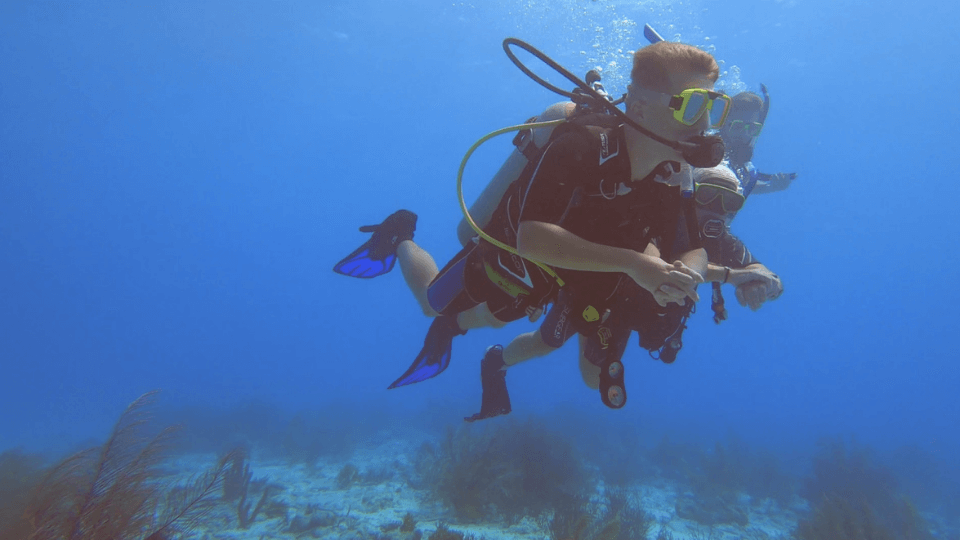7 Tips to Help You Master Shore Diving On Bonaire

Why is the Diving on Bonaire Called “Divers Paradise”?
We’ll Show You Why and Let You Discover the Best Tips for Enjoying Shore Diving in Bonaire
When it comes to our favorite activity on Bonaire, shore diving takes the lead! In this post, we’ll provide you with the best tips and tricks to make the most of your underwater adventures.
While most divers worldwide opt for boat dives as the norm, shore diving can initially seem daunting. Navigating paths paved with loose stones and dealing with waves during entry and exit can be less appealing compared to the familiar boat diving experience. It’s no wonder divers often associate boat diving with convenience and comfort.
The prevalence of boat dives globally is grounded in two fundamental facts. Firstly, reefs are typically situated several miles offshore. Secondly, a higher number of divers leads to larger groups, resulting in increased profits for operators with minimal staff.
Bonaire stands out geographically, featuring what we call an adjacent reef rather than a barrier reef like most other places. This unique setting allows the reef to start right at the beach, providing easy access for diving with friends and family or an exploration with an expert guide.
To fully enjoy the freedom of safe and exciting shore diving on our lovely island, we’ve compiled a set of tips and tricks. Let’s dive into the first one!
Tip 1: Participate in the Marine Park Orientation Dive
Once mastered, diving on Bonaire is very easy. The diving is often best at shallow depths between 30 and 50 feet or even less. Yet you do need to know where to go, how to go in, and how to spot currents and other potential hazards. That’s why STINAPA requires all dive operators on Bonaire to do a marine park orientation . This orientation will cover a bit of history, species that you’ll likely see and their role in the ecosystem as well as do’s and don’ts, expert tips and at Flamingo Diving, the staff will show you around the incredible house reef giving tips on your first day of diving.
Tip 2: Mimic the animals!
We petty humans have not evolved to be in the water, let alone under it. So taking inspiration from our aquatic friends will help us better navigate these alien surroundings.
How does this work? We’ll start by locating appropriate entry and exit points. The yellow stones on the shore are typically located near the easiest entry/exit point for the reef you’re about to dive, but that doesn’t mean that you shouldn’t look out! Storms could’ve moved loose stones, making an entry a little bit further, maybe even easier than the one that’s marked. So use your judgment and eyes before even stepping a foot in the water.
Now let’s take inspiration from our first animal, the crab! When entering the water, use what we refer to as the crab walk. Walk sideways, knees slightly bent, exploring the next step with your foot before putting weight on there. It might seem silly, but it works, and if it keeps you from falling over, hurray!
Hold on to your buddy because that’s what buddies do. It’s not uncommon to hear “no thanks, I’m fine” from another group of divers. These are famous last words before they trip over a loose rock, after which divers, now rolling in the surge, typically still keep exclaiming that they’re fine. So folks, no macho business! Crab walk, crab walk, crab walk!
Tip 3: Watch the Corals
On Bonaire, we’re blessed with large healthy patches of shallow water corals like fire coral and stag horn coral. These corals often reach up all the way to the surface of the water. In order to avoid touching them, follow the light blue sand paths and steer clear of the darker patches in the water. Use your mask and maybe even snorkel to navigate your way offshore before you start diving.
Once underwater, do not touch anything. Use the famous rule “take only pictures, leave only bubbles” during all of your dives. practice great horizontal trim to avoid kicking up sand. Sand can cause great damage when it lands on corals so keeping proper distance and trim is essential. You can also try and up your “turtle mimicking” skills by joining an Advanced class or getting some one on one training from one of our pro’s.
Tip 4: Wind in the Sails, Pirates!
Bonaire is known for its often strong trade winds that famously bombard the island’s east coast with huge rolling waves. The west coast, however, is completely sheltered from this mayhem and often looks more like a pool than the ocean.
Pay close attention to the wind direction though. If, for example, due to a mistake or leaky O-ring, you find yourself running low on air and decide to snorkel back to shore, dive sites like Invisibles or Salt Pier are located so that the wind points directly toward the open ocean, so swimming back can be quite exhausting.
Always plan your dive with plenty of reserve air, dive shallow, turn around at about 1700psi or 120bar, and slowly make your way back to the shallows where you have all the time in the world to finish your magnificent dive without worrying about getting back in a rush.
If you’re still not sure about your diving skills or just want to see the coolest stuff in the most efficient way, book a guided dive.
Tip 5: Watch the Currents
With boat diving, if a current is too strong, you typically just inflate your SMB and wait for the boat to pick you back up. Shore diving is a little different, and surface currents, often caused by wind, are not a great marker to know what’s going on underwater. For novice divers, our advice is to be cautious of dive sites located close to sharp corners or funnels in the island’s geography, like Lighthouse point, Something Special, and Red Slave. Currents can often be unpredictable and switch on a dime.
So what do you do when you encounter currents? First of all, make sure your buddies are aware of the signal for currents (fist on a flat hand pointing in the direction of the current). You can easily check the current’s direction at different depths by just looking at the direction the soft corals are pointing in. Always start your dive against the current, and if it switches on the furthest point, and you have plenty of other dive sites to exit from, just make it a drift dive! Let one buddy stay with the gear while the other picks up the truck and drives over. Real exciting stuff. So currents need to be respected but can also be a lot of fun.
Pay extra close attention to dive sites like Red Slave and Lighthouse; it’s not uncommon for people to end up at sea in an oceanic current over there. If you wish to dive those harsher places and have the appropriate experience, get a dive guide to show you around or even help you explore the rugged east coast of the island.
Tip 6: Navigation made EASY
All accessible dive sites are on the west coast of the island, meaning that when using a compass, east, northeast, or southeast typically gets you closer to shore. Check the exact heading prior to going underwater.
Our tip for navigation is swimming out to a site buoy snorkeling. On the way, look for visual markers that you can easily recognize on your way back. Descent, note the depth of the buoys mooring block, and start diving in the appropriate direction. When heading back, after your safety stop or minimum-deco ascent, swim at the depth where the buoy mooring is located, and you will find it again!
Then use the visual markers that you identified earlier as a way to find your way back to the exact entry point and earn cool points by impressing all your scuba friends with your impeccable intuitive navigation skills!
Tip 7: Do both Guided Dives as well as Diving With Your Buddies
Use our expertise of decades of diving on Bonaire by booking a series of guided dives. Learn the history of the Hilma Hooker, discover the Salinas (salt baths) and their cultural and economic backstory when diving Salt Pier. Let them show you rare species of which they know the exact location or take you on a rugged, harsh but rewarding east coast dive and much, much more. Then, combine it with diving with your own buddies to experience the freedom of diving on Bonaire.
Before you know it, boat diving will seem odd. Seeing a group of 20 divers jumping off the boat following a DM just 100ft off-shore, while you just walk in in a private setting on your own clock. Let’s just say it’s the best form of therapy.
In summary
-
Enjoy the Marine Park Orientation: Dive confidently after mastering essential skills provided in the mandatory marine park orientation, including historical insights, species knowledge, and a guided tour.
-
Be Cautious with the Crab Walk Entry: Safely enter the water using the crab walk technique inspired by our crustacean friends. Prioritize safety and always dive with a buddy.
-
Practice Buoyancy and Respect for Marine Life: Maintain a safe distance from corals and marine life, emphasizing excellent buoyancy control for a responsible and enjoyable diving experience.
-
Check Winds and Currents for Safe Diving: Stay informed about winds and currents, avoiding rough dive sites without a guide. Plan your dives with safety in mind.
-
Utilize Navigation Tips for Coolest Diver Status: Stand out in your group with impeccable navigation skills. Use visual markers and compass navigation to enhance your underwater experience.
Bonaire is known for over 60 dive sites from north till south. Book your guided dive today and let us know where we may take you.
